3.10 - demand side policies -> monetary policy
1/31
There's no tags or description
Looks like no tags are added yet.
Name | Mastery | Learn | Test | Matching | Spaced |
|---|
No study sessions yet.
32 Terms
demand-side policies (demand management)
focus on
changing aggregate demand
shifting the aggregate demand in the AD AS diagram
to counteract the effects of economic fluctuations
types of demand side policies (2)
stabilization policies
monetary policy
fiscal policy
****in practice: the most the policies can do is lessen the severity of business cycle
monetary policy
set by central banks
to control the money supply and interest rates
in order to manage economic stability and influence aggregate demand.
commercial bank
financial institutions that are to
hold deposits
make loans
transfer funds
buy government bonds
for their customers
central bank
a governmental financial institution with several important responsibilities
has a degree of independence
ensures that monetary policy can be conducted in the best long-term interest of the economy
without interference from political pressure
central bank responsibilities
banker to the government
banker to commercial banks
regulator to commercial banks
conduct monetary policy
goals of the monetary policy
low and stable rate of inflation (~2%)
low unemployment
controling cyclical unemployment during deflationary gap
reduce business cycle fluctuations
promote a stable economic environment for long-term growth
external balance
balance between exports revenue and imports spending
inflation targeting
monetary policy framework that aims to
maintain a specified level of inflation, typically around a target rate
advantages of inflation targeting
achievement of low and stable rate of inflation
improved ability of economic decision-makers to anticipate future fluctuations
greater co-ordination between monetary and fiscal policy
knowledge about inflation targets allows government to plan fiscal policies
disadvantages of inflation targeting
reduced ability of the central bank to pursue other macroeconomic objectives
reduced ability of the central bank to respond to supply-side shocks
to control cost-push inflation/ stagflation it may have to sacrifice its inflation goal
a too low target may lead to higher unemployment
interest rate
a percentage of the amount borrower is charged by a lender for the use of funds on top of the normal payment
supply of money (Sm)
the total amount of monetary assets available in an economy at a specific time
fixed level decided upon by the central bank
it is a vertical line as it doesn’t depend on the rate of interest
changing the money supply is to influence AD
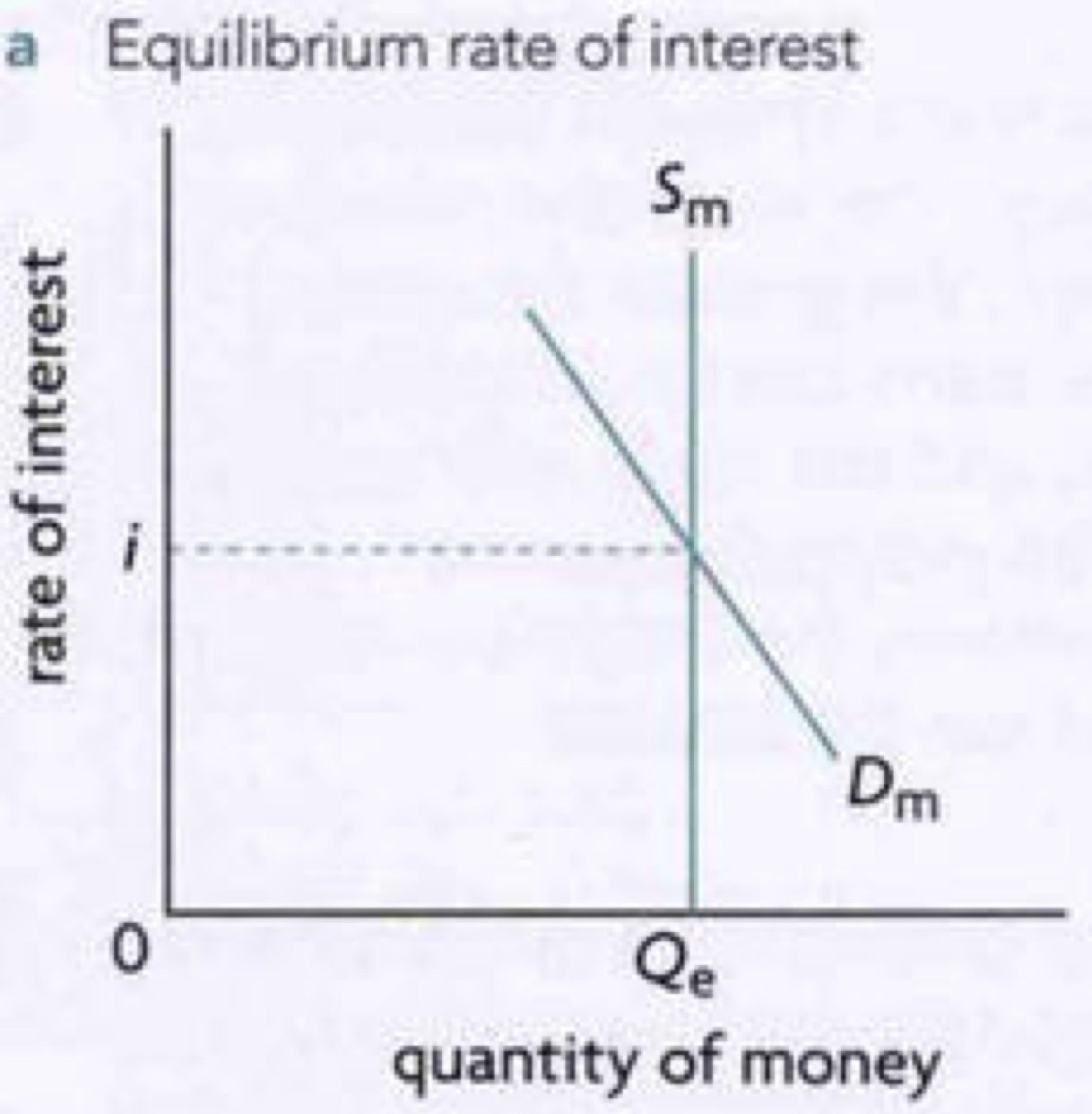
demand for money (Dm)
interest rates fall = increase in holding money demanded by the public
*the higher the interest rate the less attractive it is for you to hold money, and better off to put into banking account that earns interest
**money itself doesn’t earn interest
shift of Sm
if central changes the money supply Sm curve shifts
this determines a new rate of interest
demand for holding money changes
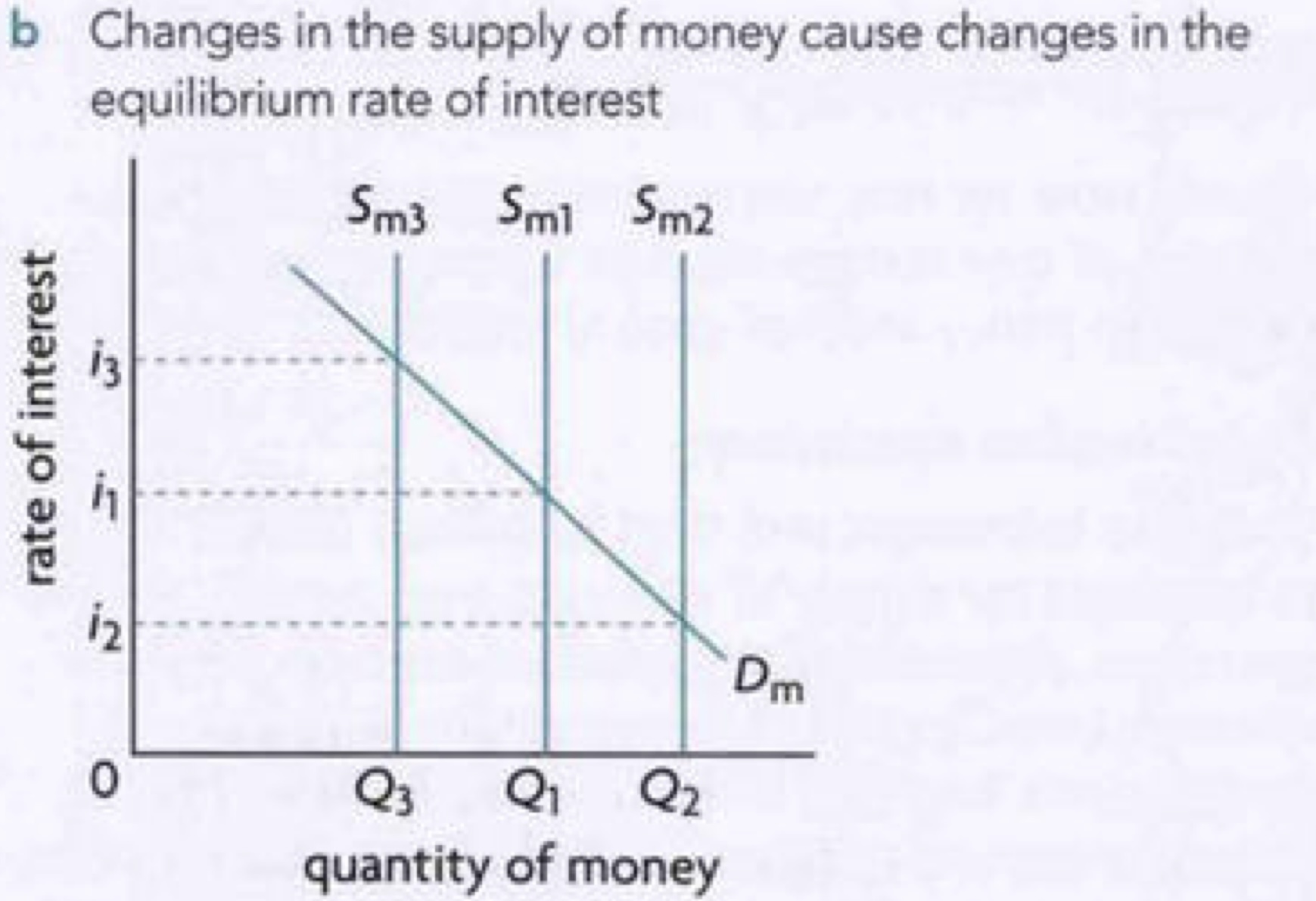
setting a target interest rate
central bank sets a target interest rate it wants to achieve
then takes steps to adjust the money supply so that the actual equilibrium interest rate will become equal to the target interest rate
minimum reserve requirement/ required reserve ratio
funds that the central bank must legally keep, which are a fraction of total deposits
excess reserves
funds that banks hold beyond the required reserve ratio, which can be used for lending and investing.
monetary multiplier
monetary multiplier = 1 / required reserve (as a percentage of deposits)
fractional reserve system → amount of new loans/ new money created
(1/minimum reserve requirement )x excess reserves
*it is the maximum amount that can be created
tools of monetary policy to influence the supply of money
open market operations
minimum reserve requirements
changes in the central bank’s minimum lending rate
quantitative easing
open market operations (operations by use of bonds)
to lower the interest rate (increase money supply) the central bank will:
buy government bonds from commercial banks
increase excess reserves in commercial bank
ability to make more loans
thus increasing money supply
* do opposite for decreasing money supply
minimum reserve requirement
to lower the interest rate (increase money supply) the central bank will:
lower minimum reserve requirements
increasing excess reserves in commercial banks
thus increasing money supply
*do the opposite for decreasing money supply
changes in the central bank’s minimum lending rate
minimum lending rate = the interest rate at which the central bank lends to commercial banks.
to lower the interest rate (increase supply of money) the central bank will:
lower minimum lending rate
higher commercial bank excess reserves
thus increasing money supply
*do the opposite to decrease supply of money
quantitative easing
central banks buy huge quantities of assets that commercial banks have or own
to pay for those assets central bank creates reserves electronically for the commercial banks
commercial banks end up with many more reserves which they can use to make a lot of loans, increasing AD
to lower the interest rates (increase money supply) the central bank will:
create new reserves electronically
increased excess reserves in commercial banks
increased money supply
nominal interest rate
the stated interest rate before adjustment for inflation.
real interest rate
the nominal interest rate adjusted for inflation
reflects the true cost of borrowing and the true yield to lenders
effect of changing interest rates/ money supply on AD
affects
investment
consumption
higher interest rate = more saving = less consumer and business borrowing/ spending = left shift of AD (fall)
expansionary monetary policy
increase in the money supply by the central bank
to expand AD
in case of a deflationary gap
*with demand for money constant interest rate falls from i1 to i2
lower cost of borrowing
consumer and businesses more likely to borrow and spend more
increased (right shift) of AD
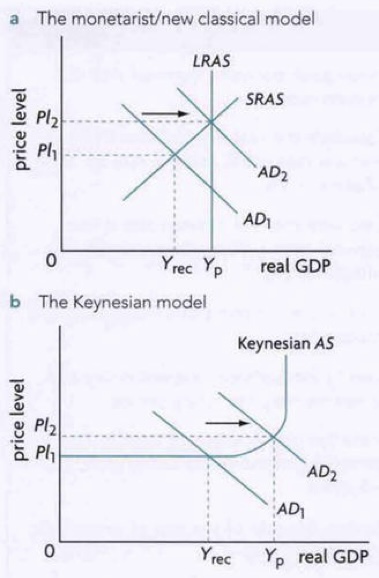
contraction monetary policy
decrease in money supply by central bank
to decrease AD
to mitigate inflationary gap
*with demand for money constant interest rate rises from i1 to i3
higher cost of borrowing
consumer and businesses more likely to borrow and spend more
increased (right shift) of AD
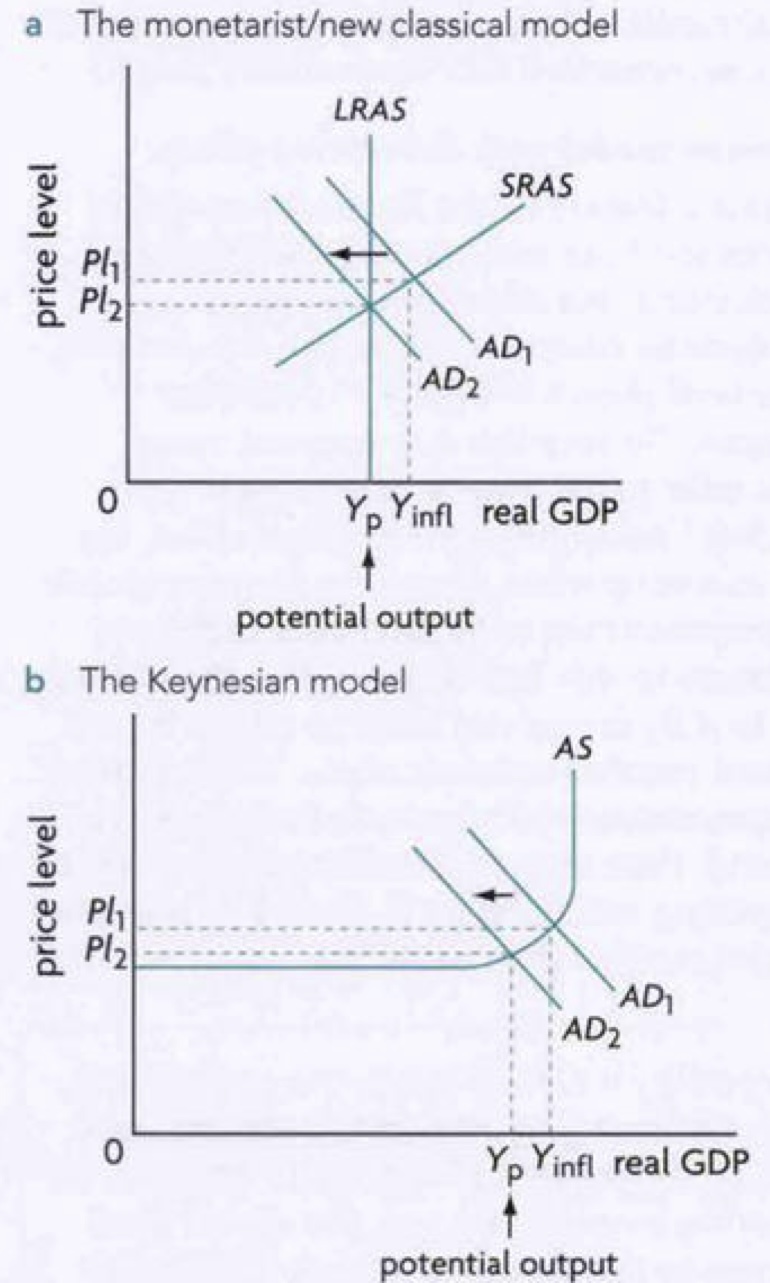
Ratchet effect on the keynesian model of contractionary monetary policy
ratchet effect
price moves up as AD moves up
price stays constant as AD moves down
more realistic representation of what happens in real world
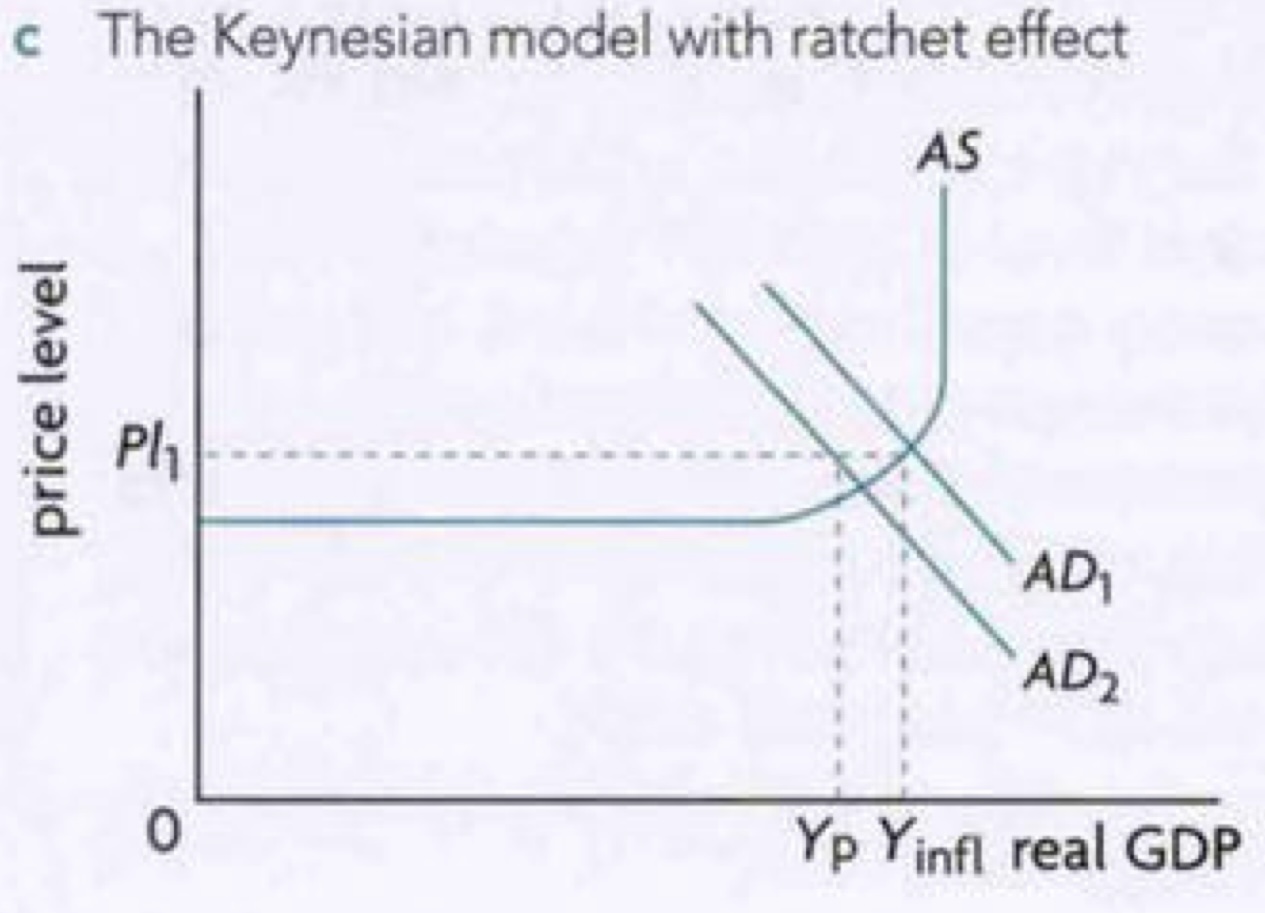
constrains on monetary policy
possible ineffectiveness in recession
interest rates cannot fall when approaching zero
low consumer and producer confidence
banks may be fearful of lending
conflict between governmental objectives
may be inflationary
when the policy lasts too long it may push the AD over the necessary value to eliminate a deflationary gap
unable to deal with stagflation or cost push inflation
strengths of monetary policy
interest rate changes can be gradual
interest rates changes are reversible
monetary policy is flexible
relatively short time lags
days for the change to apply
central bank independence
limited political constraints
as it doesn’t involve making changes in the government budget
no budget deficit or debt
no crowding out